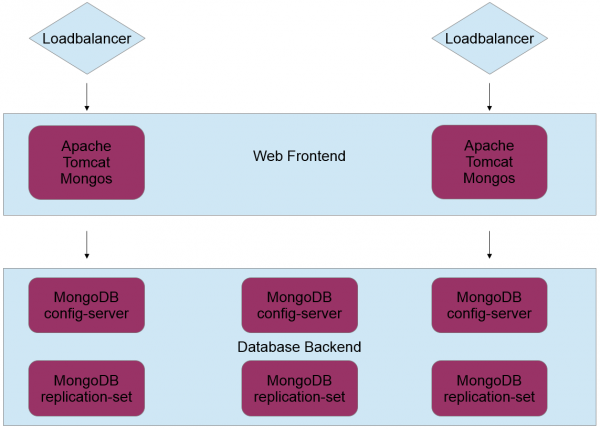Infrastructure
From OpenCellID wiki
Contents
Servers
| Server | Software | Operating system | Resources |
|---|---|---|---|
| prod-ocid-web-01.colt.enaikoon.de | Apache + Tomcat + MongoS | Ubuntu 12.04 LTS | 2 vCPU, 4 GB |
| prod-ocid-web-02.colt.enaikoon.de | Apache + Tomcat + MongoS | Ubuntu 12.04 LTS | 2 vCPU, 4 GB |
| prod-ocid-cfgsrv-01.colt.enaikoon.de | MongoDB ConfigServer | Ubuntu 12.04 LTS | 1 vCPU, 2 GB |
| prod-ocid-web-02.colt.enaikoon.de | MongoDB ConfigServer | Ubuntu 12.04 LTS | 1 vCPU, 2 GB |
| prod-ocid-web-03.colt.enaikoon.de | MongoDB ConfigServer | Ubuntu 12.04 LTS | 1 vCPU, 2 GB |
| prod-ocid-db-01.colt.enaikoon.de | MongoDB Replication Set | Ubuntu 12.04 LTS | 4 vCPU, 48 GB |
| prod-ocid-db-02.colt.enaikoon.de | MongoDB Replication Set | Ubuntu 12.04 LTS | 4 vCPU, 48 GB |
| prod-ocid-db-03.colt.enaikoon.de | MongoDB Replication Set | Ubuntu 12.04 LTS | 4 vCPU, 48 GB |
Software stack
Operating System
All OpenCellID servers are running with Ubuntu Linux 12.04 LTS.
Frontend
- The web frontend uses Apache web server as a proxy for serving web requests to Tomcat.
- The OpenCellID web application is running on Tomcat and is reading and writing cell measurements data to/from the MongoDB database backend.
- jQuery Mobile is responsible for providing a cross-platform user interface.
- The map is displayed using OpenStreetMap combined with Leaflet library.
Database Backend
- The database backend, with a current 4.4 million cell towers and about 565 million measurements (1.1.2014), is a MongoDB database cluster with six servers:
- Three servers are serving as MongoDB configuration servers
- The other three servers are serving as database backend with one replication set spread across the three servers
Challenges and solutions
The OpenCellID community is very strong and continously provides a high number of measurements.
This immediately poses a few challenges:
- High Volume
data arrives from many differnet sources and is rapidly growing - Scale
growth of data should go along with predictable, incremental costs and no downtime should be needed when adding additional server resources - Data Processing
analyzing and processing of rapidly growing data must be constantly efficient.
The current solutions are based on MongoDB and its features:
- Native Analytics
using the integrated aggregation framework and Map/Reduce to calculate aggregates and analyses in place without the need of prior exporting data to other systems - Advanced Geo Queries
using geospatial MongoDB support to execute complex queries - Horizontal Scaling
sharding makes it easy to scale applications horizontally on commodity hardware for accommodating constantly increased throughput - Reduced Total Cost of Ownership (TCO)
as open-source storage MongoDB is a very cost-effective solution
